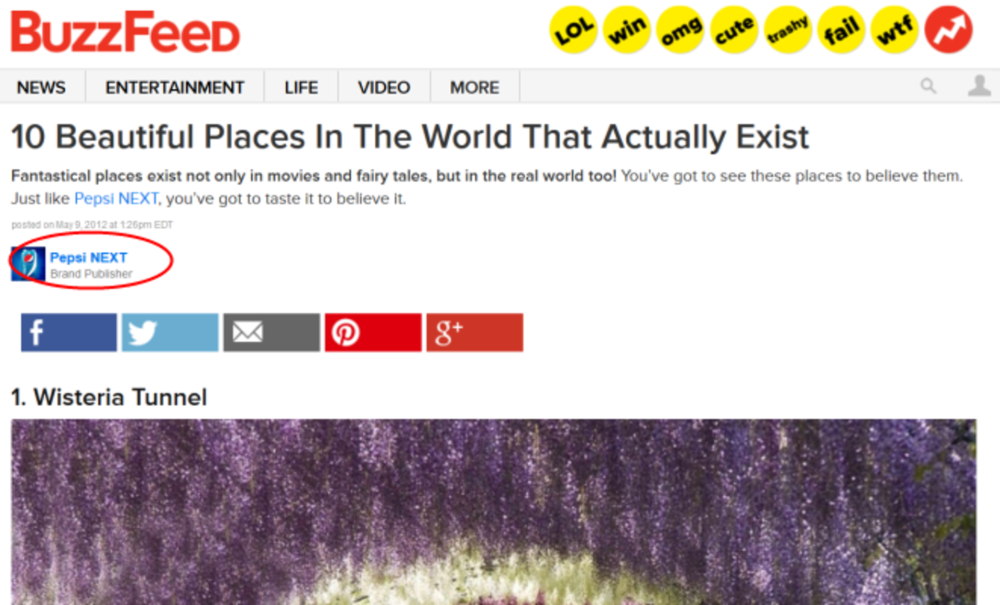The Holy Grail of advertising is targeting and relevance—to anticipate the user’s immediate needs and interests and provide content that is native in the context of the user’s experience. Perhaps the most powerful shift in online marketing toward greater targeting and relevance is the rise of native advertising.
Native advertising has gone mainstream, driven by brands looking to position their advertising in a way that is less intrusive, more integrative, and that fits more seamlessly into the user’s overall experience. Instead of online banner ads that interrupt the user experience and are easily ignored as they are in the “advertising” space, native advertising enables brands to more seamlessly integrate themselves when and where consumers are viewing content.
Audiences have shifted to social media and spend more time consuming content via mobile devices than ever—which makes it imperative for brands to present ads and sponsored content in the “native format.” In that way, their advertising message can be seen within the content stream that is visible from Twitter and Facebook, and via the mobile screen.
Blurring the lines of “content” and “advertising”
With native advertising, the traditional lines between “content” and “advertising” are blurring—and while this has raised some concerns about maintaining editorial credibility, native advertising is also opening up new opportunities for creating content that serves the needs of audiences in new ways.
For example, sites like BuzzFeed have pioneered a new type of customized “viral content”—such as colorful and engaging lists of humorous or inspiring photos and animated GIFs, with minimal text commentary—that incorporates advertiser content along with the publisher’s content, and can be easily shared on social media. Many of these BuzzFeed articles are pieces of sponsored content that generate brand awareness and traffic for BuzzFeed’s advertisers—but most people who view these articles share because what they are viewing is engaging.
Often, native advertising works best when it doesn’t have an explicit so-called agenda connected to that particular advertiser. For example, this BuzzFeed piece, “10 Beautiful Places in the World that Actually Exist” is sponsored by Pepsi NEXT and shares a message related to exploring exciting new places that is broadly related to the overall brand messages of Pepsi NEXT. But, and this is important, the content is not clearly advertising for a specific product. It benefits readers by giving them a series of beautiful photos to enjoy—and the brand benefits by getting residual traffic and brand halo effect from people clicking the link to the brand’s website or following the brand on Facebook or Twitter.
Marketers are using native advertising in creative new ways to attach their brand messages to content that is more likely to be shared with a wider audience on social media.
How effective is native advertising?
Most importantly, from a brand’s perspective, native advertising works better than other forms of online advertising. For example, several industry studies have shown that native mobile ads deliver an average expansion rate/clickthrough rate of 1.37%, compared to average clickthrough rates of 0.35% for standard mobile banner ads, 0.14% for desktop rich media ads, and 0.1% for standard desktop banner ads.
But sponsored content is not just for viral photos and upstart websites—native advertising has gone mainstream, with major established media companies such as Forbes and Yahoo getting in on the game. Forbes expects 30% of its total 2014 advertising revenue to come from its BrandVoice sponsored content program, and Yahoo offers Stream Ads that naturally blend into the overall content stream, as well as Image Ads that use HD images for brand storytelling on Yahoo properties such as Flickr.
Even The New York Times is looking to native advertising.
“The Grey Lady” introduces sponsored content
The New York Times had significant concerns about how to introduce sponsored content in a way that would not be perceived as misleading to readers or undermine the editorial credibility of its newsroom. The first company to publish sponsored content with The New York Times was firm Dell, which introduced a series of articles on workplace issues, including, “Will Millennials Ever Completely Shun the Office?” and “For Women Entrepreneurs, Mentors Help Bridge the Gap.”
Dell’s sponsored content articles are in a style similar to New York Times feature story pieces. They’re written in an informative tone with author bylines, almost the same as a real New York Times article—but there are design elements that clearly indicate that the Dell pieces are paid posts. It’s a good example of how brands can create native advertising in a way that builds credibility and capitalizes on a media company’s the existing audience.
Native advertising: The future is now
Native advertising is a major growing force in the future of online marketing. By making native ads and sponsored content relevant, engaging, and worthy of sharing with others, brands will create greater brand awareness and affinity, leading to higher clickthrough rates, better engagement, and bigger profits.
L. Jasmine Kim is CEO of MobSoc Media. She has extensive and broad experience in consumer Internet media and commerce, from websites, mobile technology, social and local media, and all things in between.







